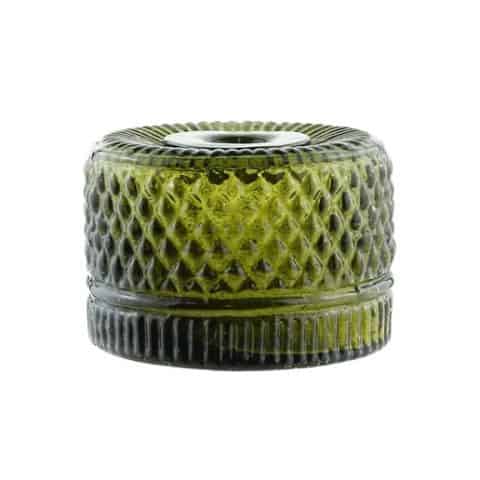GII-28 Decanter with Stopper
BLOWN THREE MOLD
Decanter with Stopper
GII – 28
Probably Keene Marboro Street Glass Works
Keene, New Hampshire
Emerald Green with Olive Striations
Provenance: Michael George Collection

Our museum example represents a brilliant emerald green GII-28 blown three-mold decanter topped with a blown mushroom stopper. The consignor acquired the decanter from a Maryland estate auction sometime around 2012 and has only seen one other like it that sold in a Harmer Rooke sale in the 1990s. Although these types of blown three-mold decanters were made in Europe, we attribute this as an American piece made from 1815 to 1825.

The three main categories of blown three-mold glass patterns are Geometric, Arch and Baroque. Diamond patterning, also known as diamond diapering or diamond quilting, is the most common geometric design and can be found on tableware items such as decanters, stoppers, cruets, casters, condiment sets, pitchers, punch bowls, pans, dishes, preserve dishes, mugs, tumblers, wine glasses, celery glasses, salts, and doll dishes.
See the museum example of a quart Blown Three Mold GII-28 Decanter in olive green.
See the museum example of a pint GVII-1 Sunburst Flask attributed to the Keene Marlboro Street Glassworks.
Our museum example was made from a mixture of bottle and lead glass. It has crude characteristics with olive-colored striations throughout, similar to the deeper-colored Masonic and sunburst flasks from the Northeastern glasshouses. Shards of these GII-28 objects have been uncovered at a glass factory site on Washington Street in Keene, New Hampshire. The decanter’s overall height with the stopper is 10 inches. An example is represented in Plate 102, #6, in American Glass by George S. and Helen McKearin.

Primary Image: Blown Three Mold GII-18 Decanter with Stopper imaged on location by Alan DeMaison, FOHBC Virtual Museum Midwest Studio
Support Image: Blown Three Mold quart decanter in olive green glass from the Michael George collection. Imaged on location by Alan DeMaison, FOHBC Virtual Museum Midwest Studio
Support: Reference to American Glass by George S. and Helen McKearin, Crown Publishers Inc., New York, 1989.
Support Image: Auction Lot 15: Blown Three Mold Decanter, probably Keene Marlboro Street Glassworks, Keene, New Hampshire, 1820-1840. Square with beveled corners, light sea green, tooled flared mouth – pontil scar, pint; (no stopper). GII-28 A heavy decanter with thick glass. Subtle and beautiful color. Fine condition. – Norman Heckler Jr. & Sr., Norman C. Heckler & Company, Auction #154
Support Image: Auction Lot 86: Blown Three Mold Decanter, England, 1820 – 1840. Gorgeous, vibrant emerald coloration, square decanter form, geometric pattern of diamonds and ribbing, fluted shoulders, tooled flared mouth with pour spout, original matching patterned stopper – polished pontil scarred base, ht. 7 ¾” (including stopper), perfect. MW, GII-28. See McConnell, “The Decanter, An Illustrated History of Glass from 1650.” Rare. A gorgeous, eye-appealing decanter. Ex. Peter Tillou collection. – John Pastor, American Glass Gallery, Auction #32
Support Images: GII-28 shards and other green examples from Michael George.
Support: Reference to American Bottles and Flasks and Their Ancestry by Helen McKearin and Kenneth M. Wilson, Crown Publishers, New York, 1978.
Join the FOHBC: The Virtual Museum is a project of the Federation of Historical Bottle Collectors (FOHBC). To become a member.


























